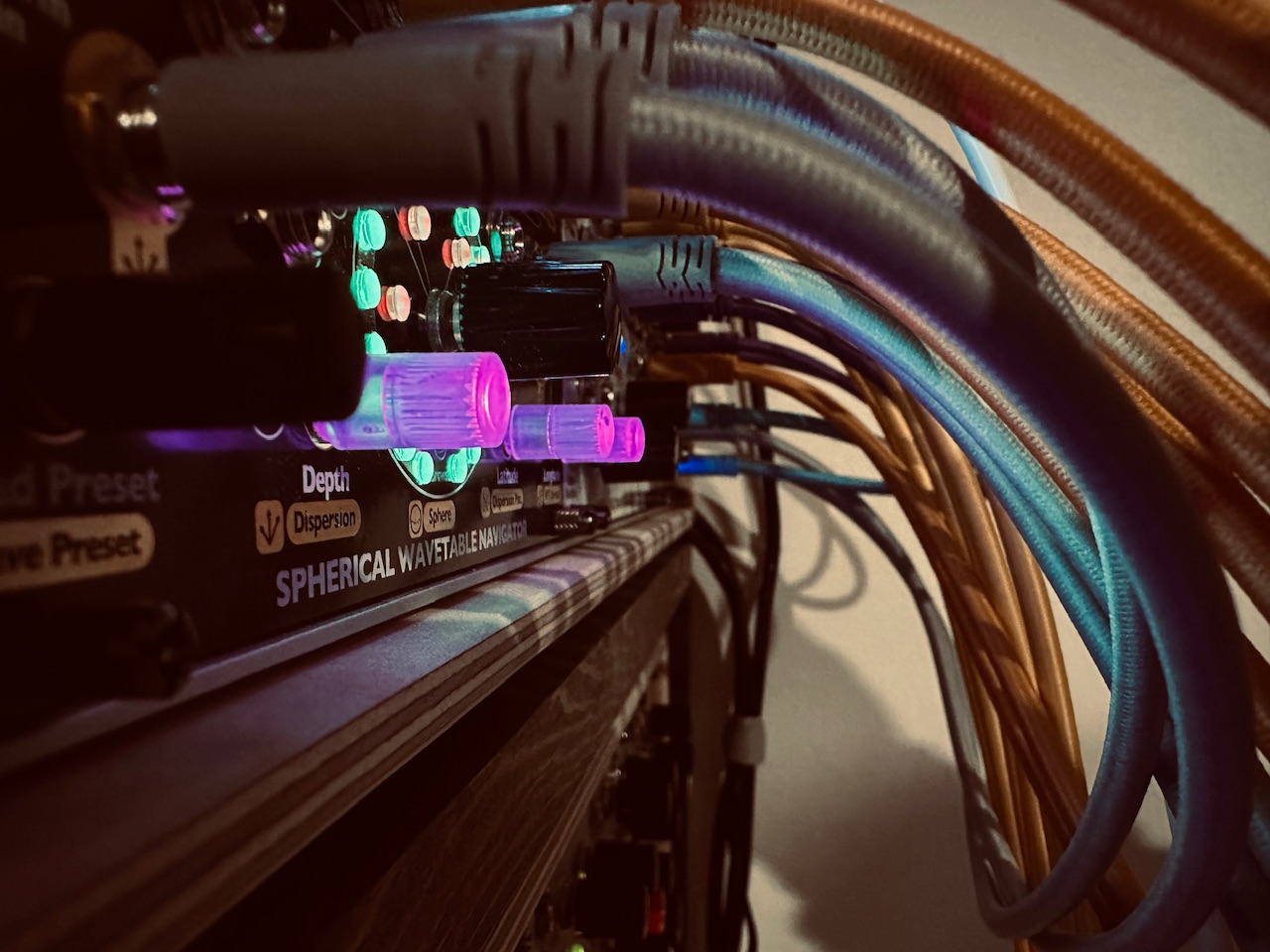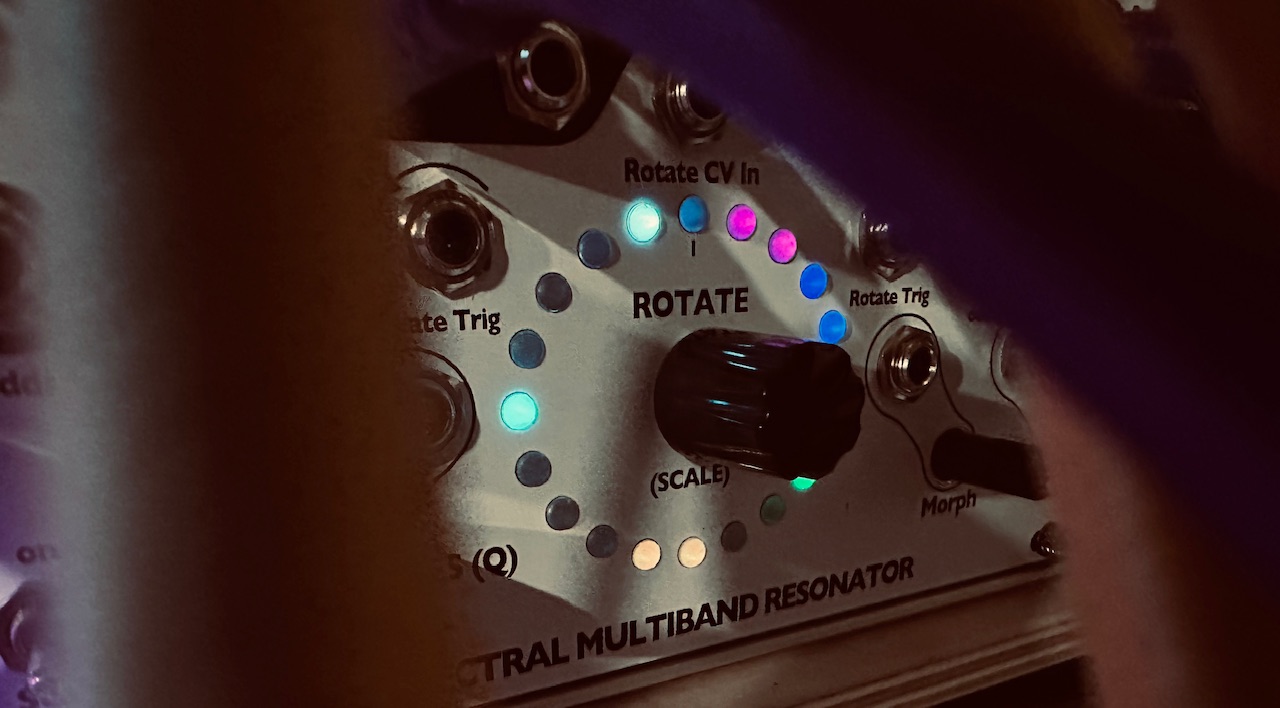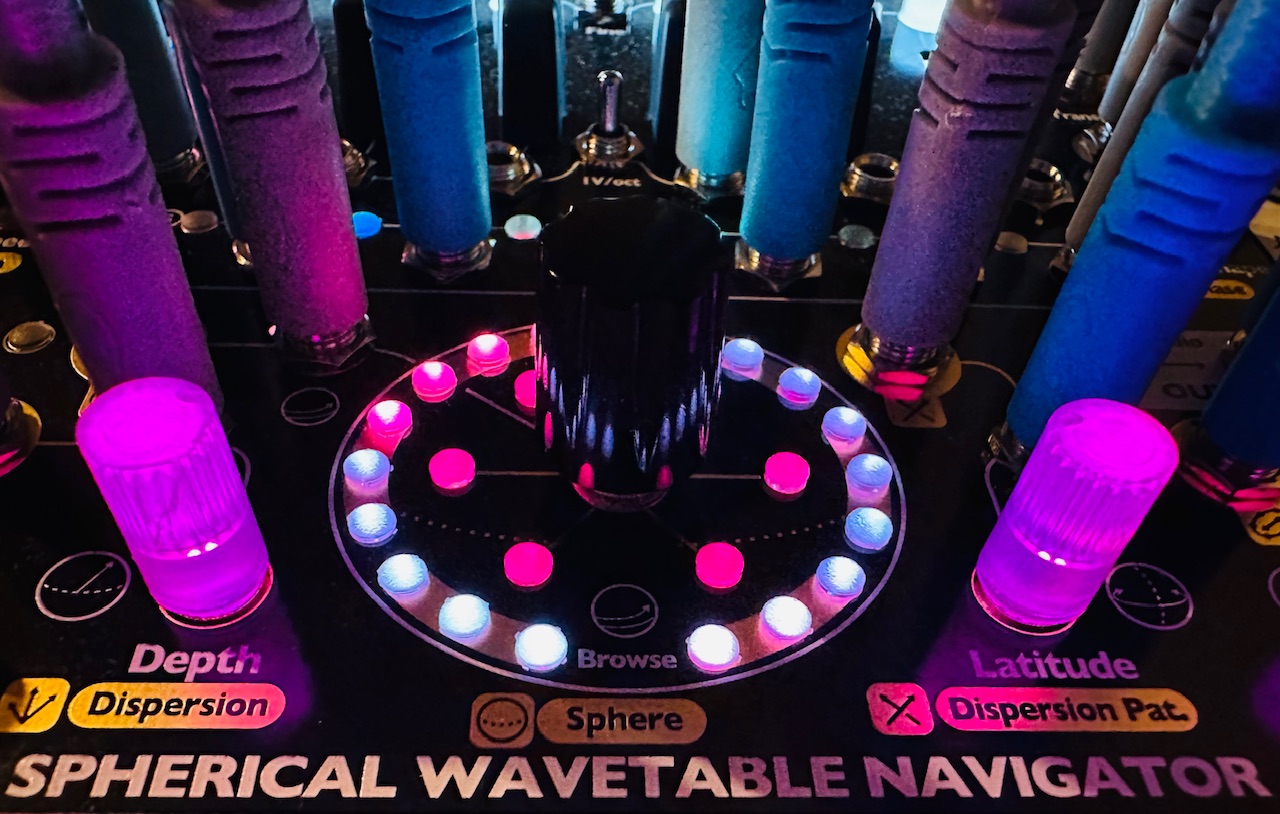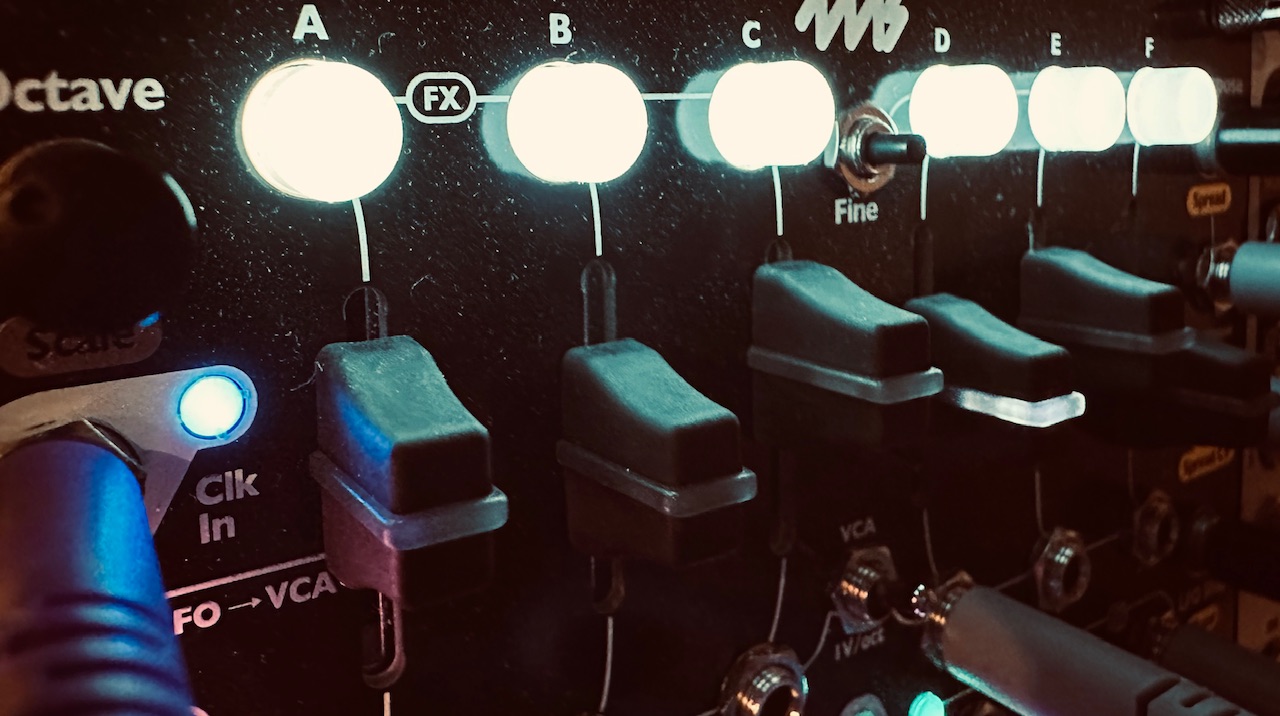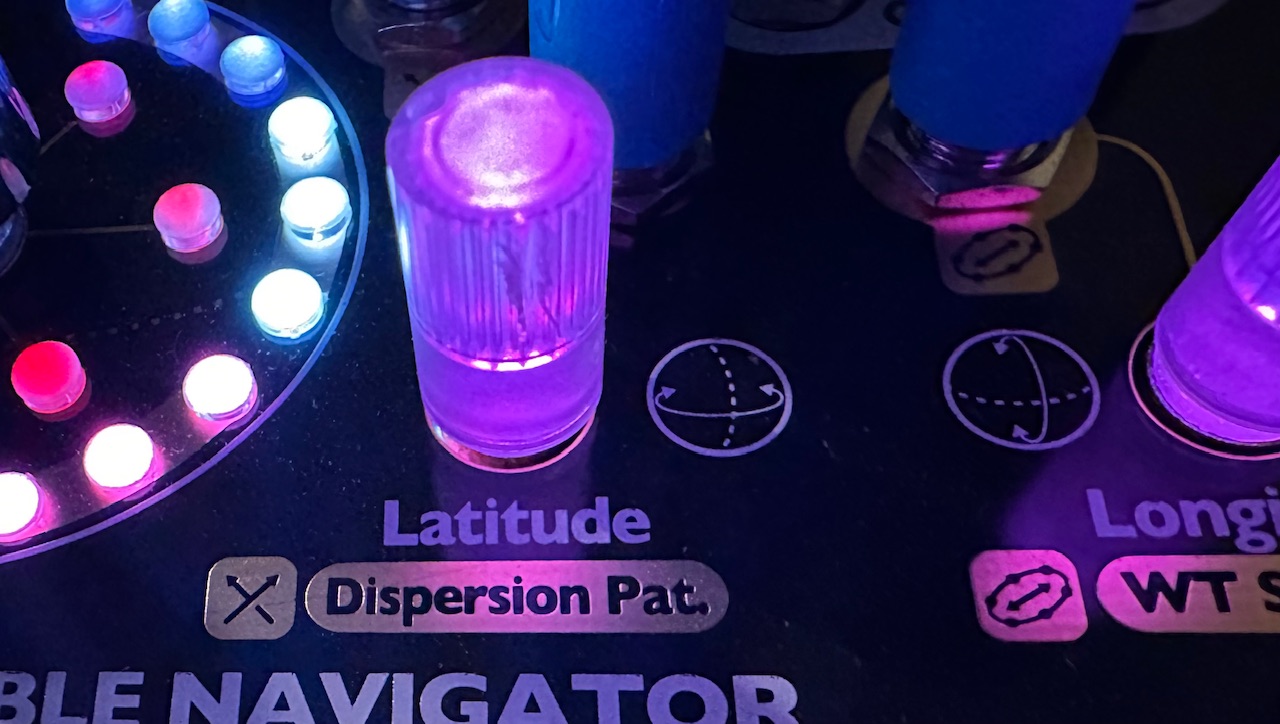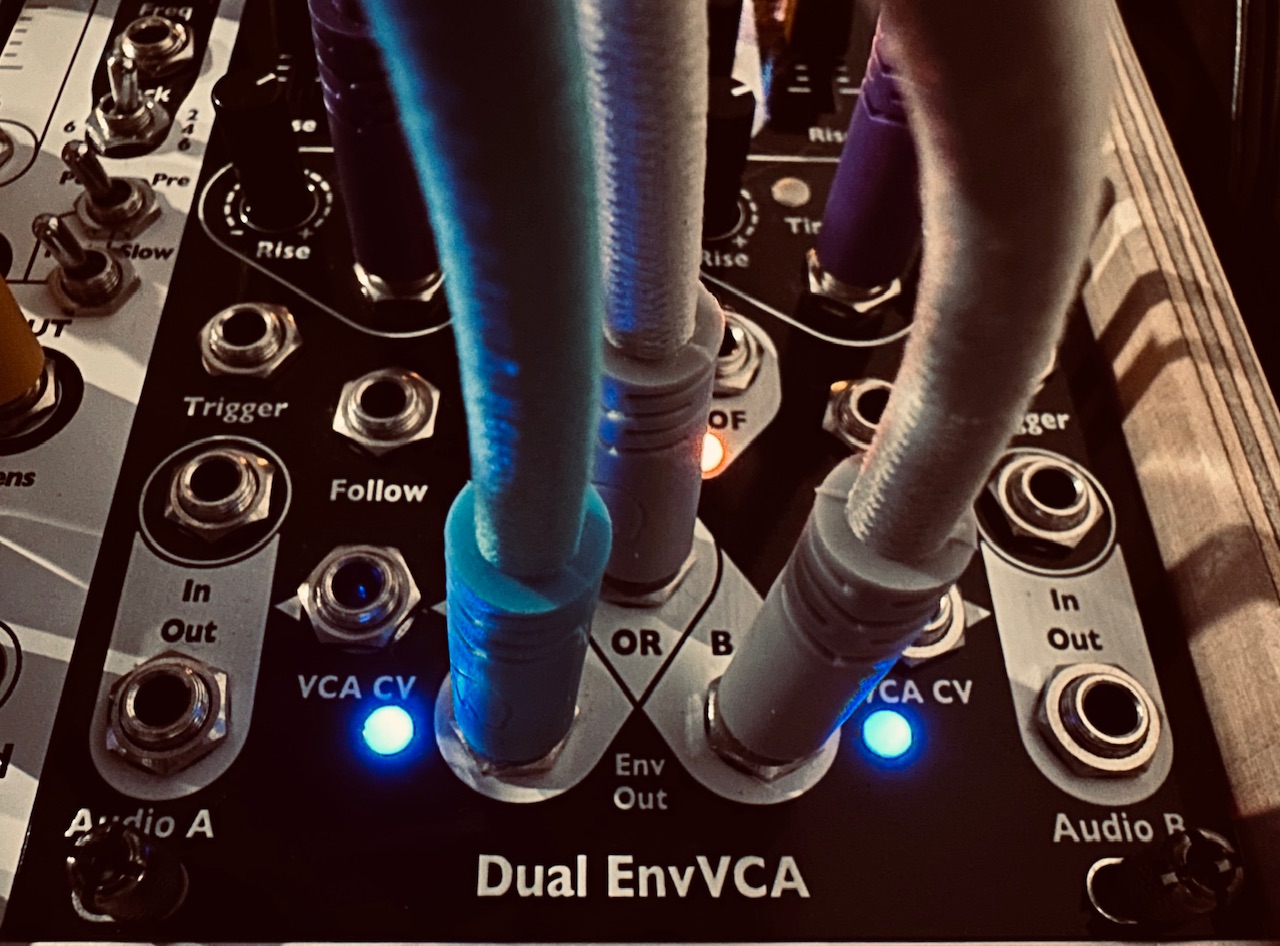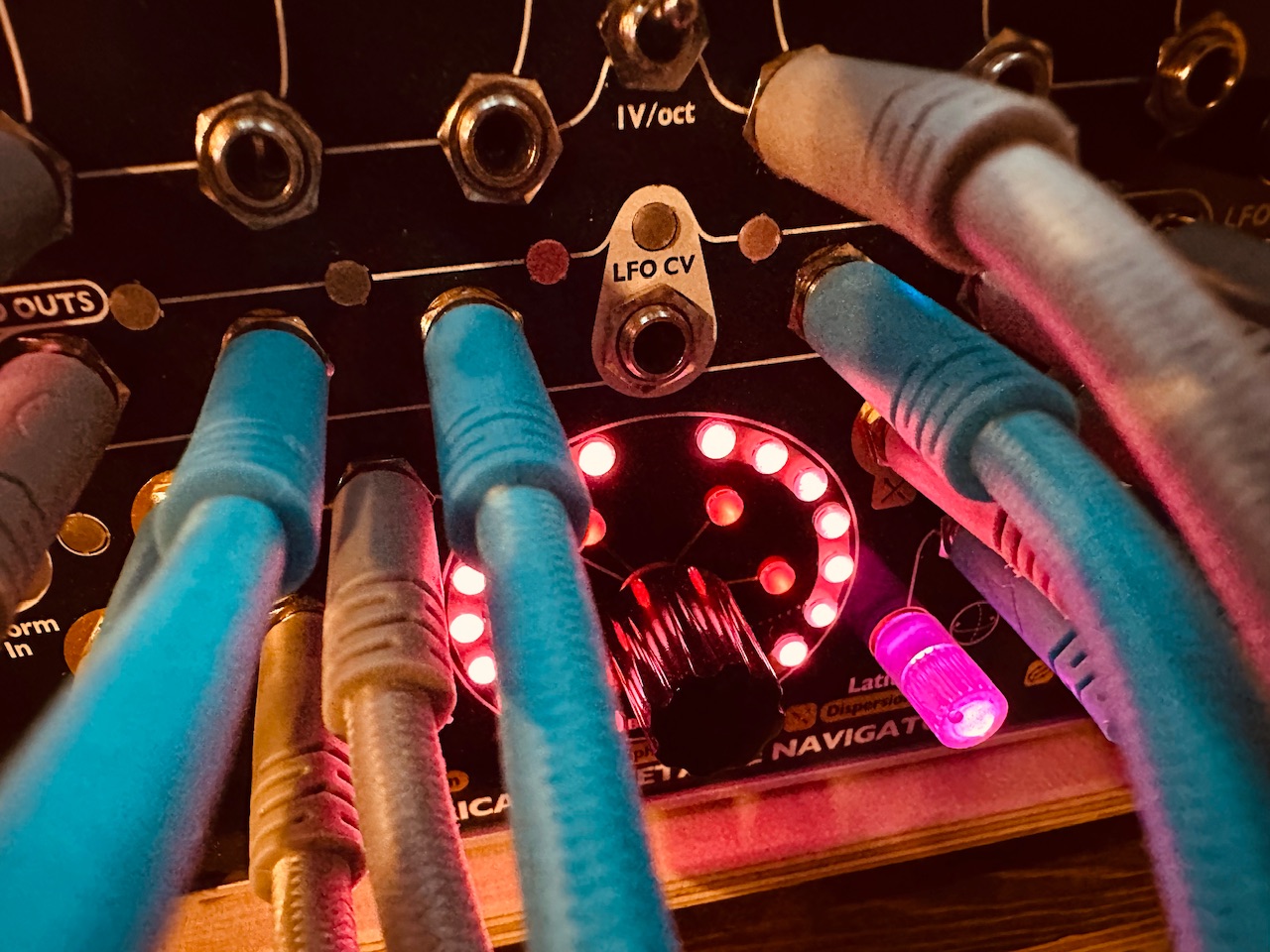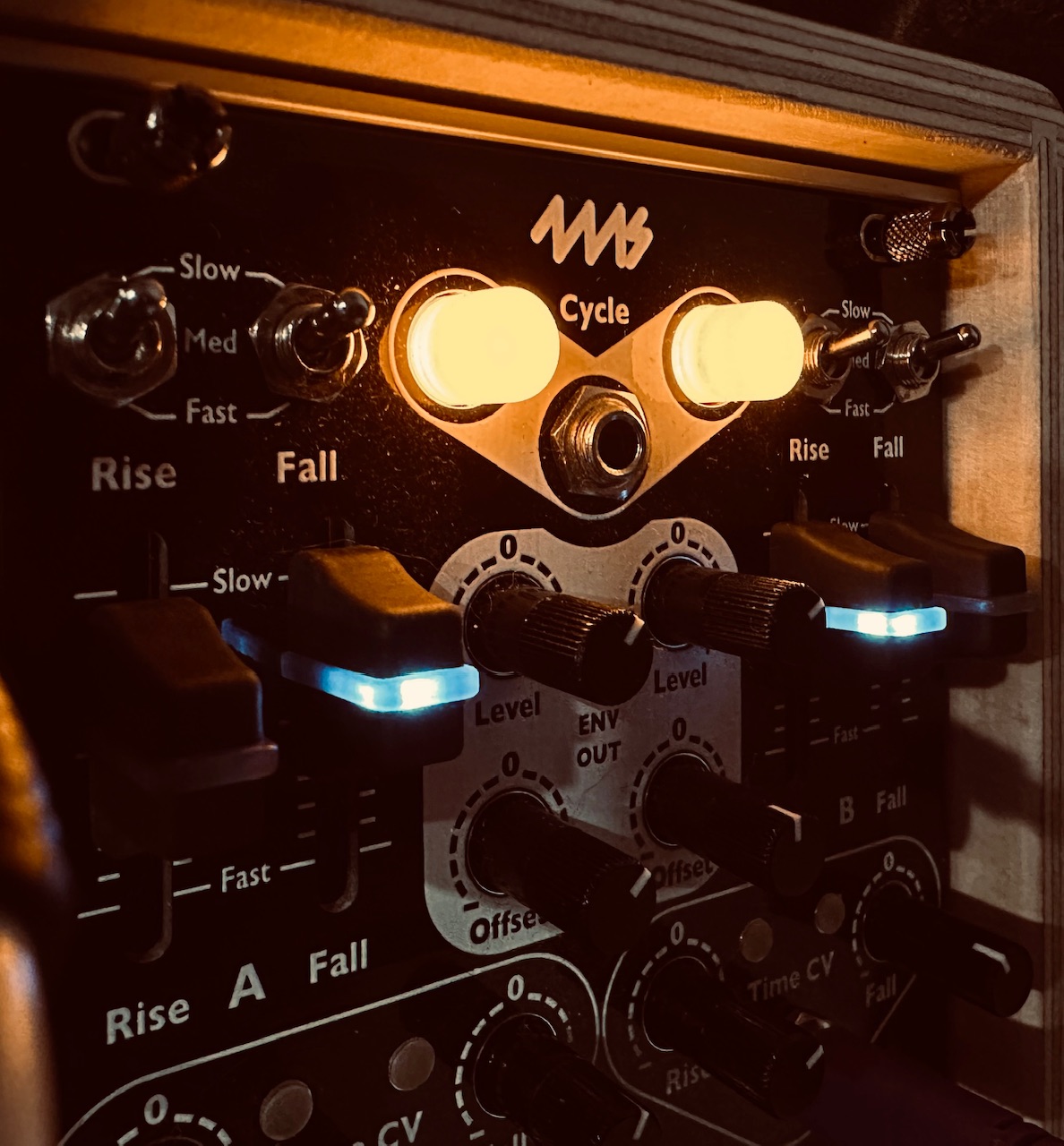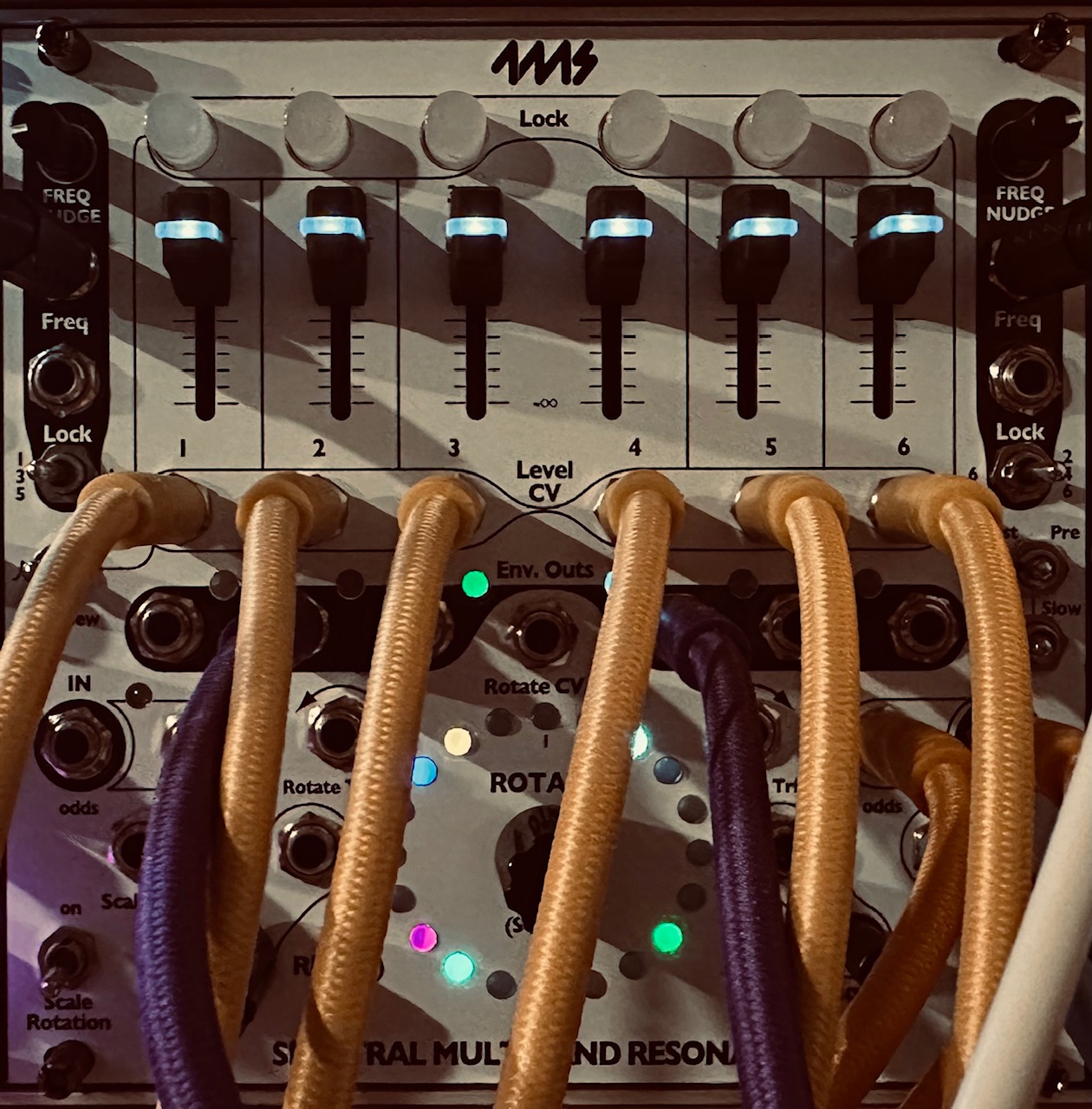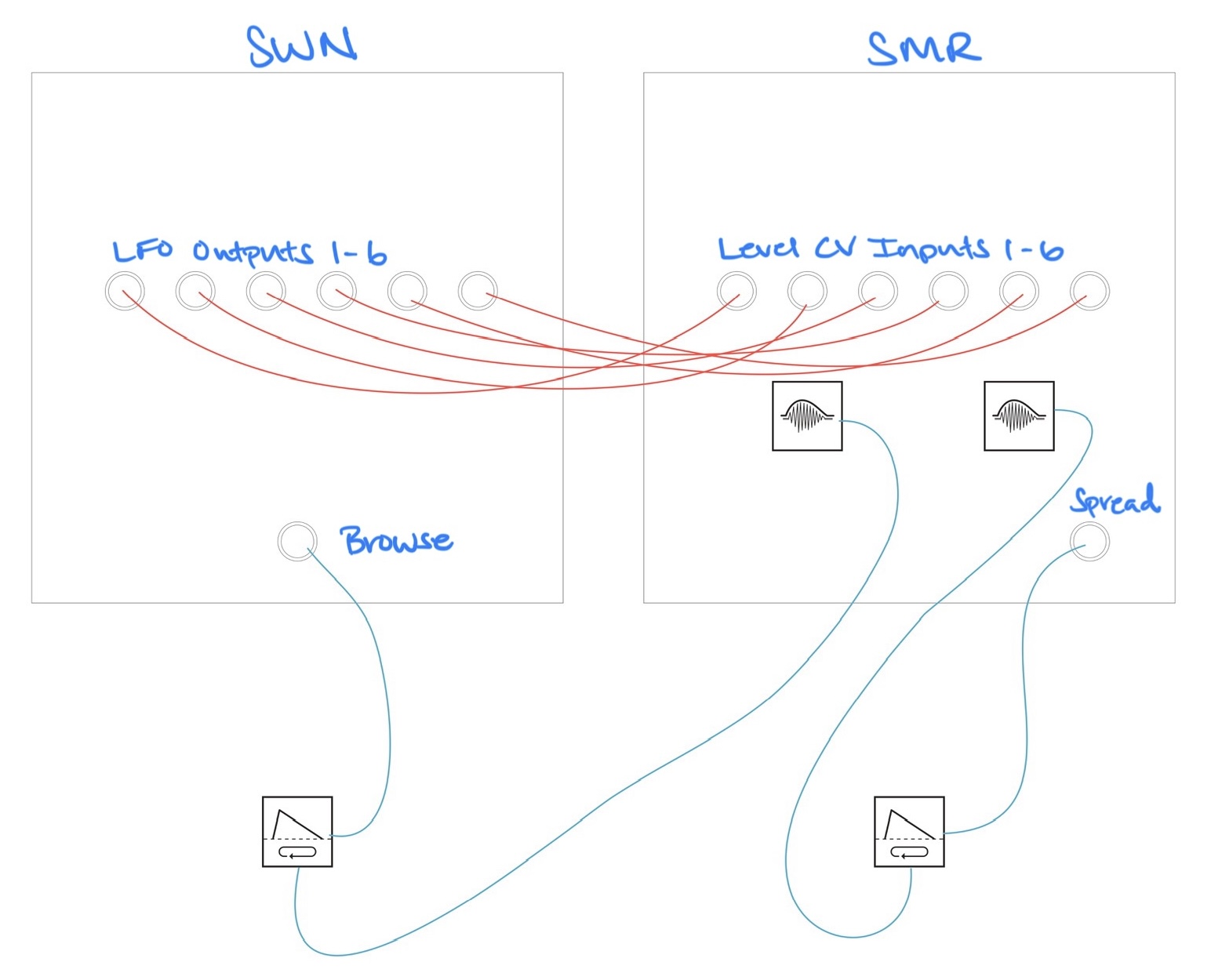Most of the time in modular synthesis drift is bad. Musicians all over will do whatever is necessary to mitigate drifting clocks or rhythms. Module makers of all sorts include resets specifically for the purpose of realigning the outputs to an incoming clock with the explicit goal of avoiding drift. Maintaining time is crucial in any beat driven track. Except when it’s not. And it’s this rhythmic drift that I wanted to explore in this otherwise beat driven patch.
It’s no secret that I like chaos. I use it for modulation or as a clock in most patches. I generally don’t expect or even desire steady clocks when I use chaos, but I also don’t generally produce beat driven compositions, and when I have I’ve tended towards uniform clocks and on-beat rhythms like most people. But today I wanted to explore a beat driven patch that uses chaos as its driving force. Rather than fear the drift, I endeavored to lean into the inherent wandering of chaotic signals while using them as lead in creating the rhythms. What I got is a wonderful dance of rhythms that want to be in line, but just can’t quite maintain their focus to make it last the whole way through. A set of rhythms that are mostly on the grid, but that occasionally drift before finally meandering their way back to the beat, like an ADHD dad in a grocery store. What we hear is the beauty of chaos in real time.
A few months ago I emailed Andrew at Nonlinearcircuits to ask for a module recommendation. I had lots of CV producers, but outside of sequencers, a clock divider, and EOR/EOC gates on function generators, I didn’t have many modules that can produce a plethora of gates. Although he had a couple of module recommendations, none came more highly suggested than Numberwang. “It’s like Let’s Splosh, but for gates” were his exact words, and I was sold. Whether using regularly timed signals like LFOs or cycling envelopes, or irregular signals like chaos or random, I’d have a gate creation machine that would be directly related to the signals feeding it.
Although I wasn’t sure how this experiment in chaos-driven rhythms would turn out, I knew I could get at least one of the waves to be in time. NLC’s The Hypster has 3 controls (frequency, gain, and damping). As explained in the Build Guide, “Damping keeps the circuits in the range of useful, somewhat regular modulation signals. As we’ll see later, more damping leads to more regular sine-like oscillations.” The guide goes on to show that although the signals are not exactly what we’d call uniform, if we use a good mixture of both both gain and damping, at least one of them will be regular(ish). Regular enough to drive a beat from. What I heard while using Natural Gate to tune the regularity of the incoming gate, saw via Numberwang’s copious blinkenlights, and with my metronome confirmed it.
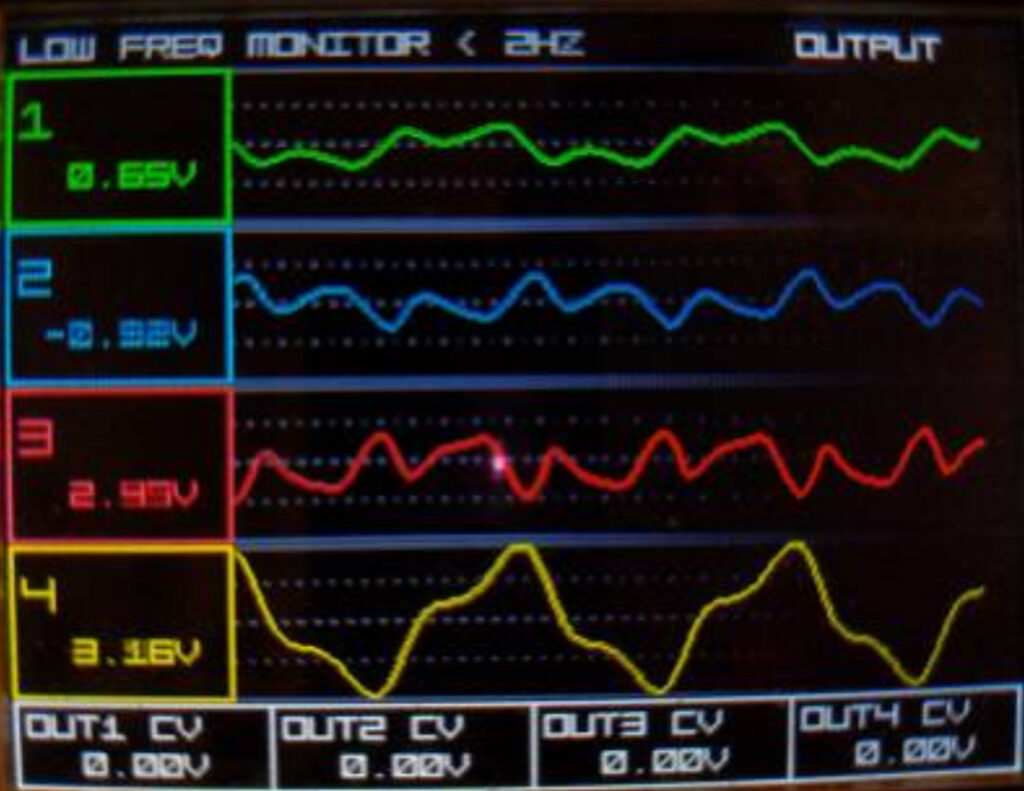
With Natural Gate pinging away on my down beat, it was time to find those drifting rhythms I was after, hoping that the chaos feeding Numberwang wasn’t too far dampened and too regular. But things proverbially fell in line all too quickly. After trying several outputs on Numberwang in order to get the perfect four beat sequence, I found it. Beat one of the gate sequence is always on time, at the blazing tempo of 53bpm. This is also the beat that controls the kick and hats (using Pam’s as a 2x clock multiplier). Gates two, three, and four drift slightly. And not in that weird, timely way that slightly out of sync clocks drift and realign,1 but in a more organic way that both speeds up and slows down around that base tempo while being on grid most of the time. It’s a playful game between the clock and its trailing rhythms, not unlike three dogs drifting around its steadily paced owner on a nice walk in the afternoon.
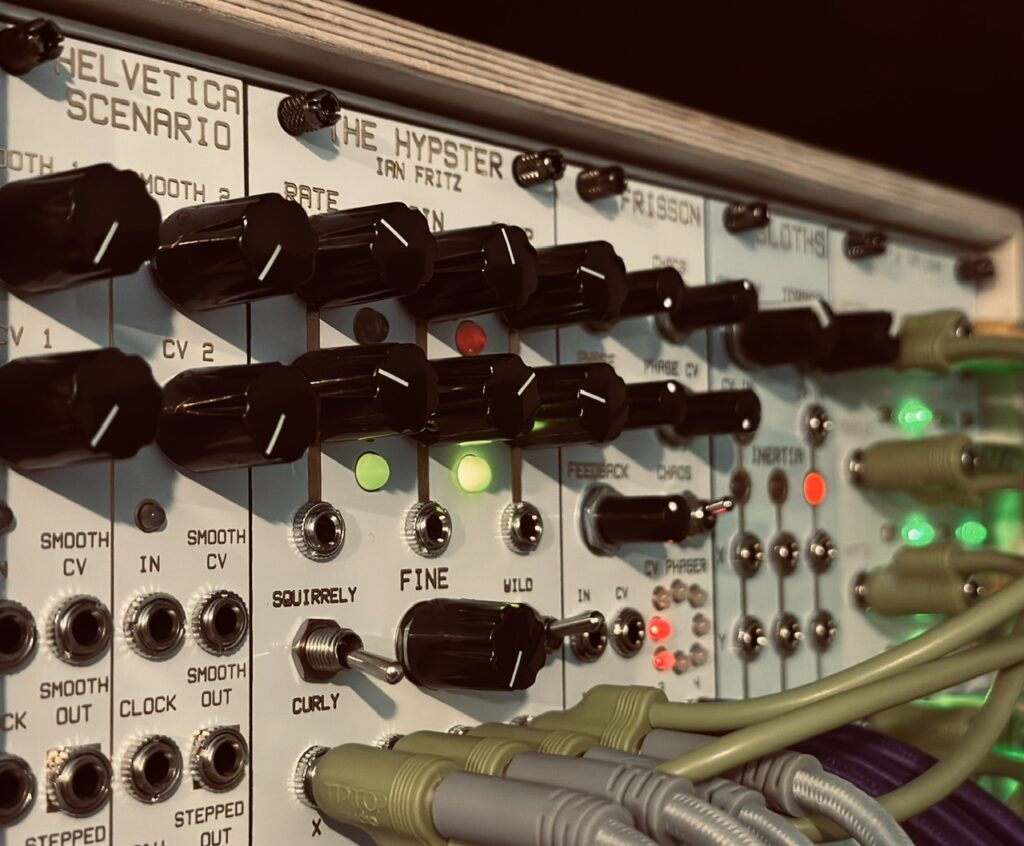
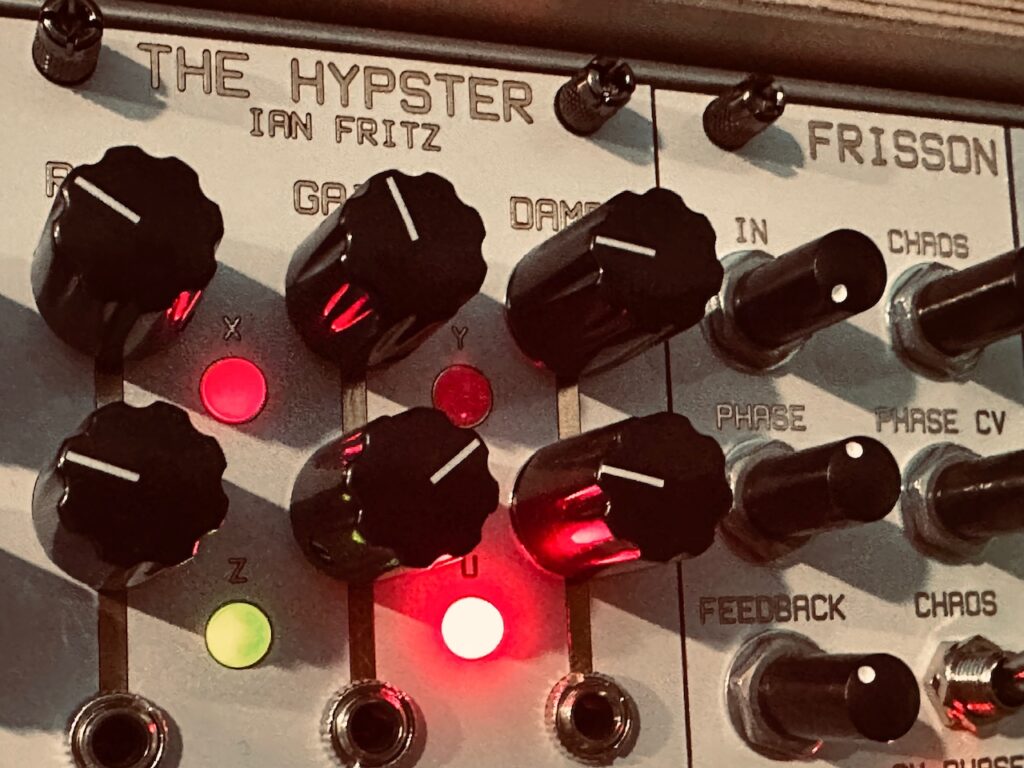
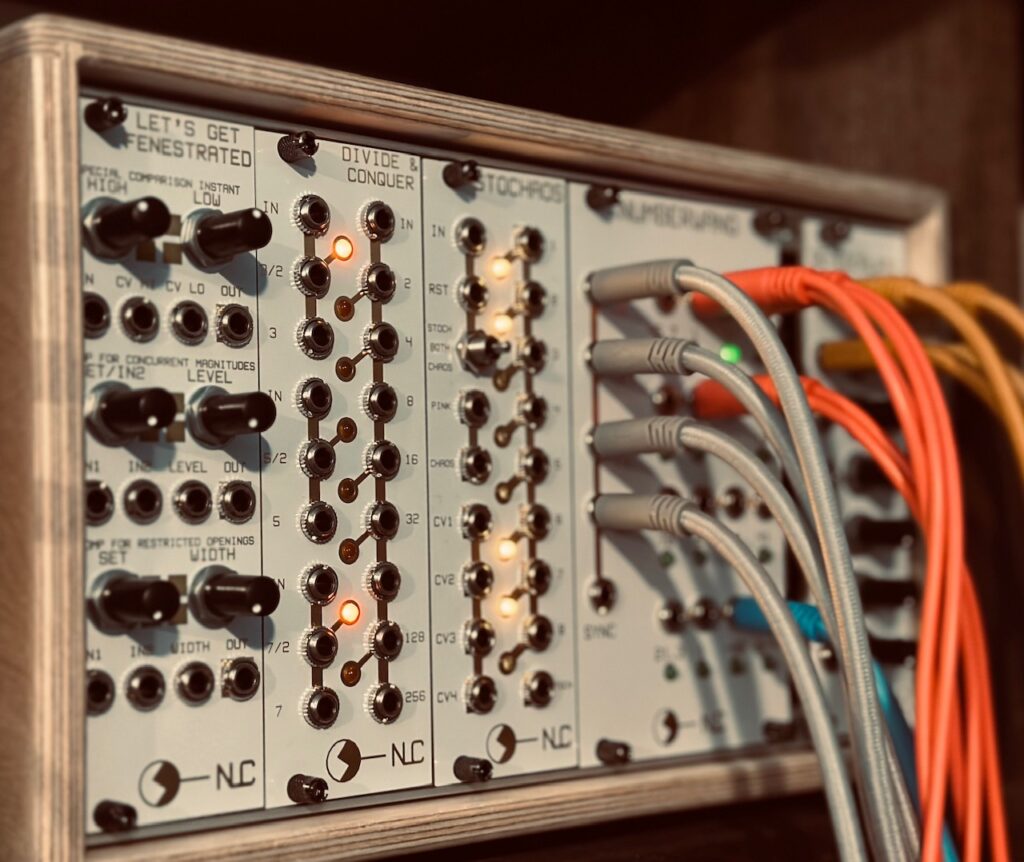
Now that I had a good gate sequence, I needed some pitch to go with it. This patch uses four outputs from the Joranalogue Generate 3 as the main sound source. All four of the outputs (odd, even, full, and core) have very different sounds and timbres, and are up to two and a half octaves apart,2 each patched to a Natural Gate input. But even though I was only using a single pitch sequence for four separate parts, I knew I wanted that pitch to be derived from the same source as my rhythms. I wanted as much of the patch as possible to be driven by those four original chaos outputs. Using a mult, I ran the same four The Hypster outputs used to create my gate sequence in Numberwang to Let’s Splosh, and randomly chose four outputs that were then mixed in the Atomosynth Transmon before making its way to Quantermain for quantization (E Japanese), and finally to Generate 3’s v/oct input. These four Let’s Splosh outputs were modulated in this very excellent voltage controlled matrix mixer via four outputs from the Nonlinearcircuits Frisson. Using four mixed sources for pitch allows for some easy flexibility when trying to add variety. A twist of any of the knobs on the mixer will give a different result in the final pitch sequence. The pitch change was being clocked in Quantermain by one of the unused Numberwang outputs, along with all four notes in the sequence at the Natural Gates’ “Hit” inputs. Once the “Open” parameter on Natural Gate was closed to give the notes definition outside of pitch and timbre changes at about 1:30 in, those same gates also triggered four envelopes on a pair of Frap Tools Falistris to modulate the “Open” parameter and give each note just a little more punch and space.
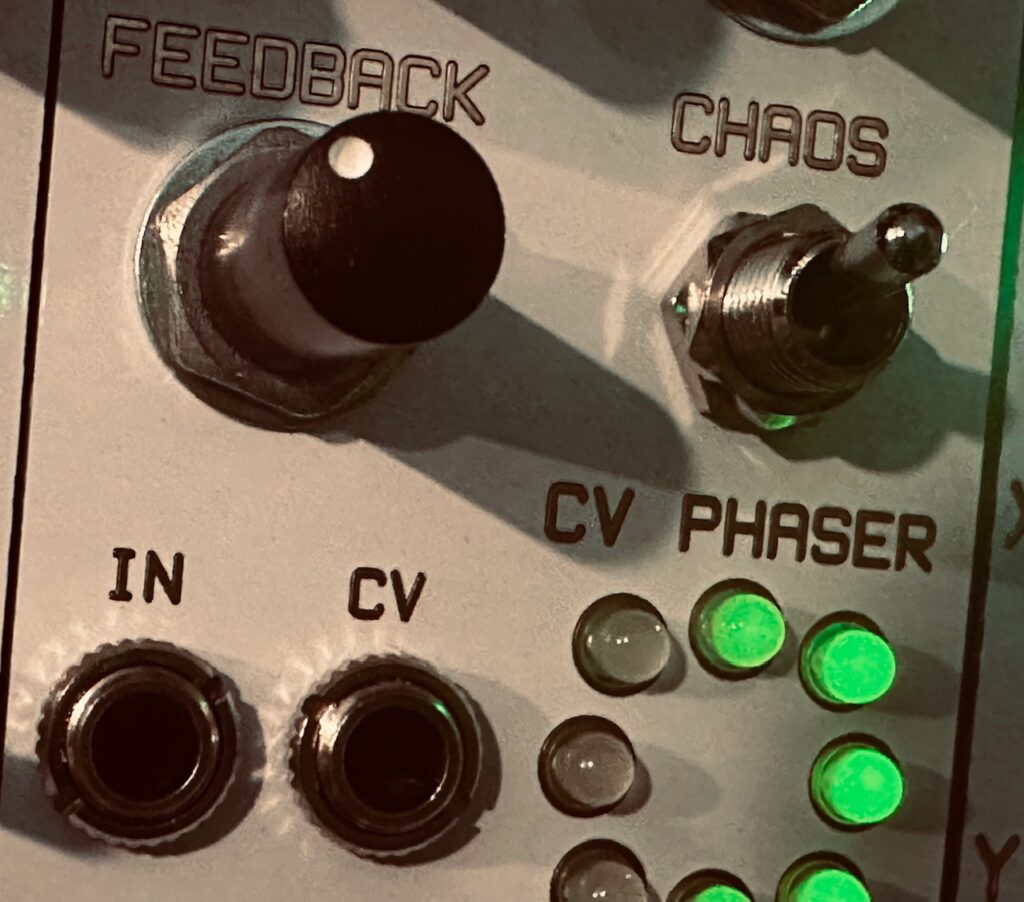
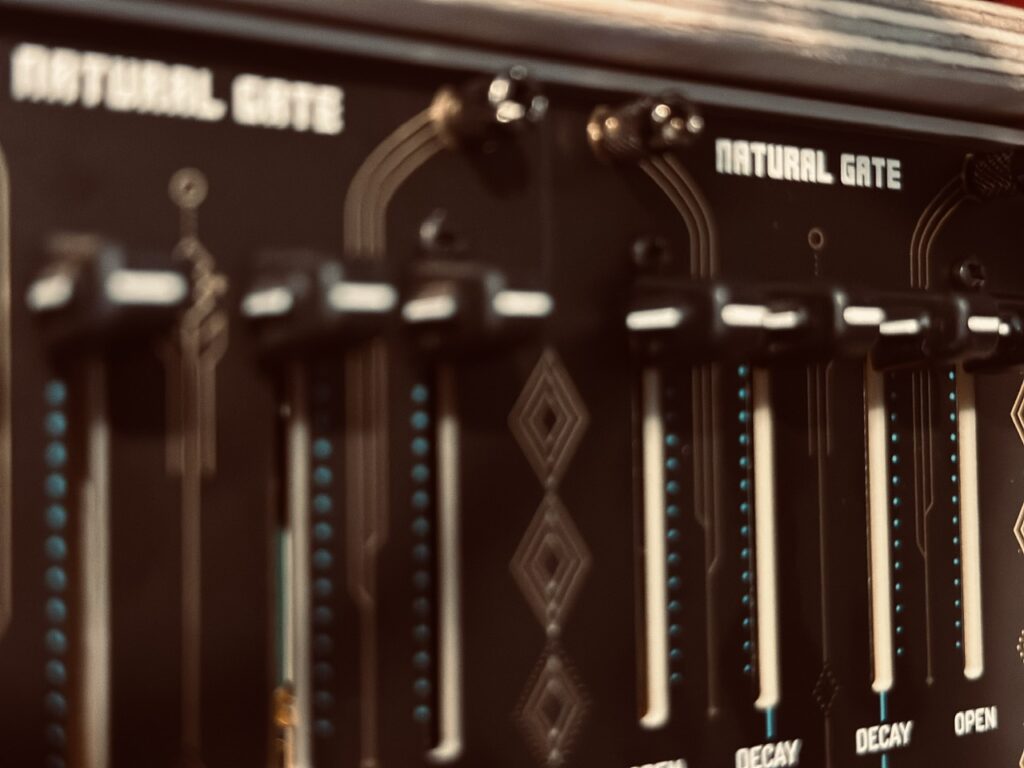
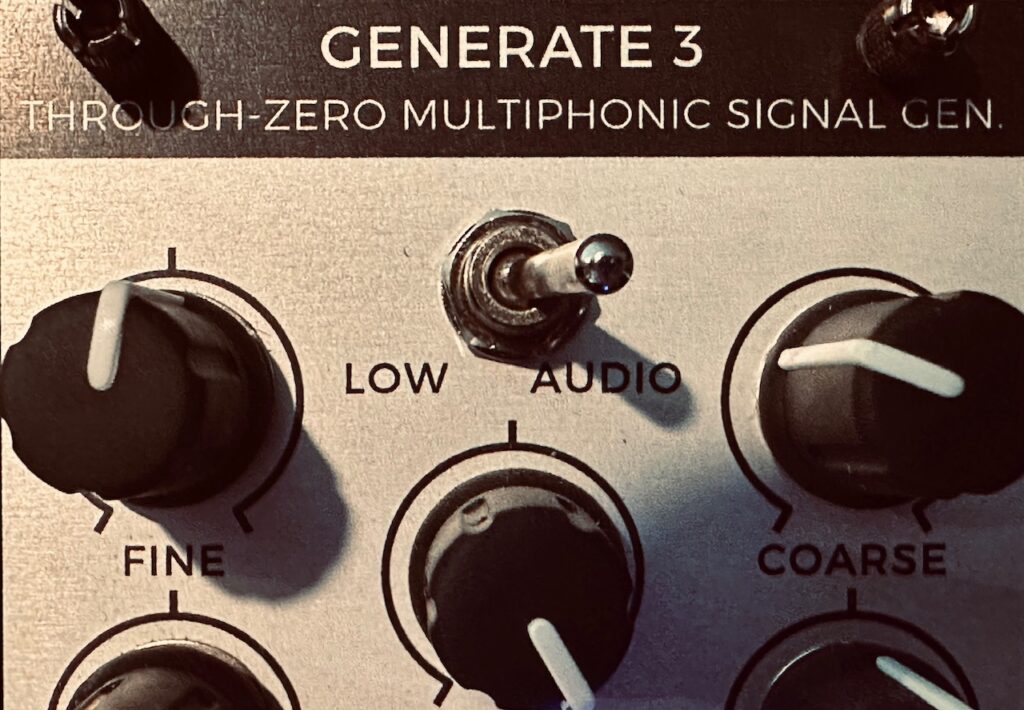
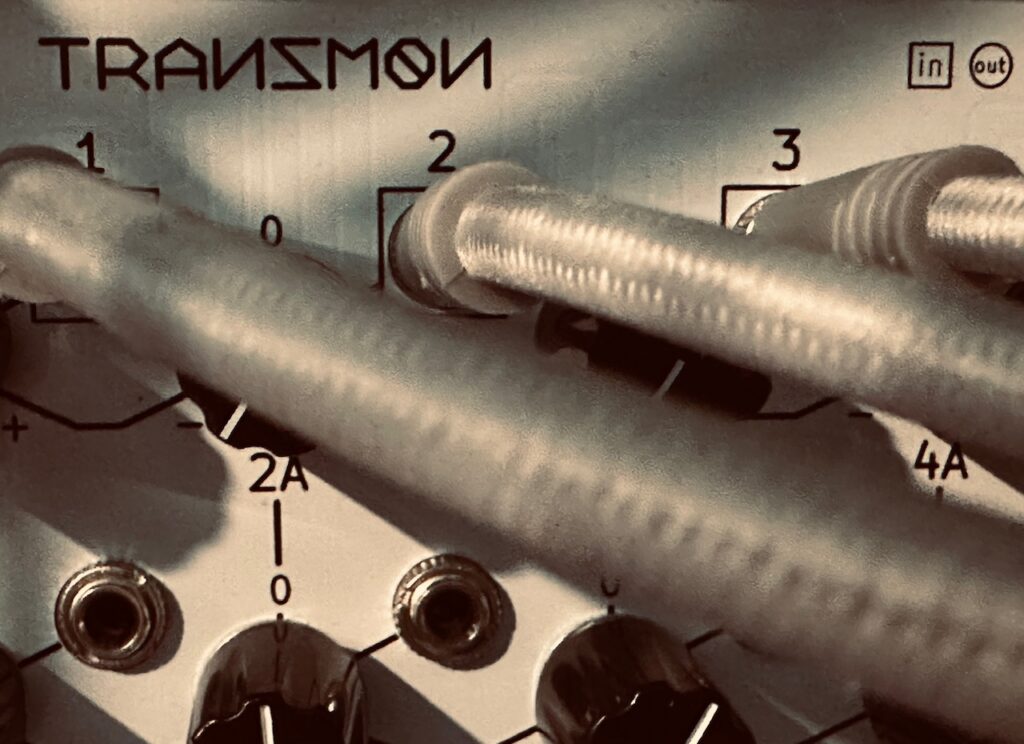
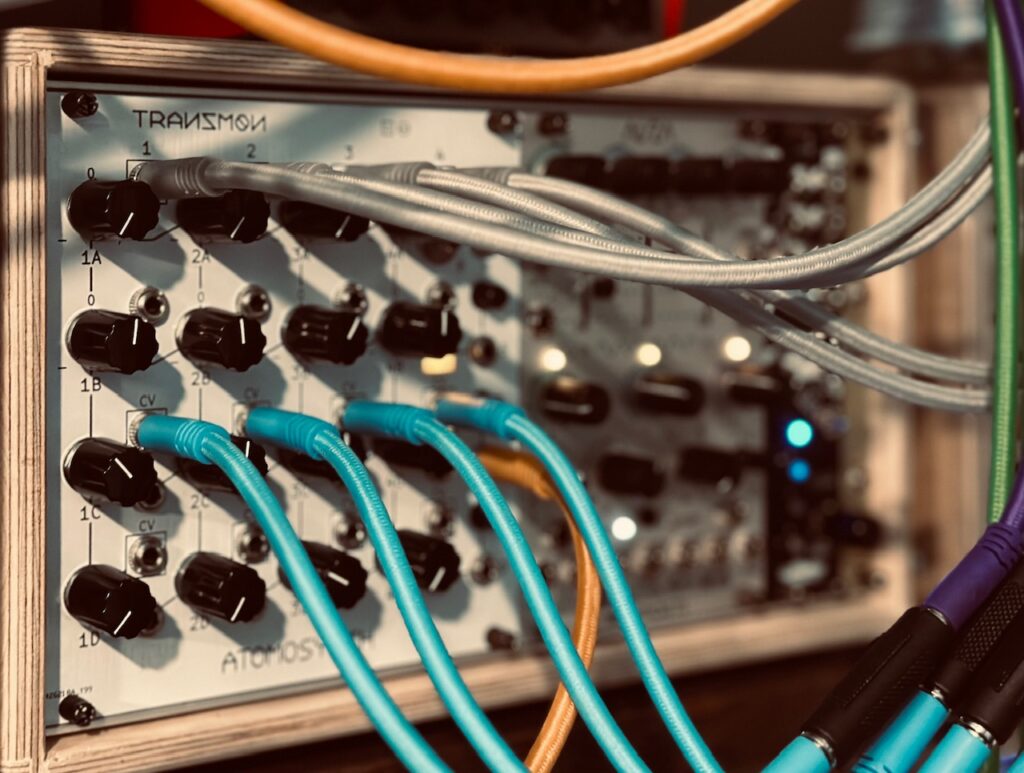
But Let’s Splosh wasn’t finished doing its part at deriving the pitch sequence, as 10 other outputs were used to modulate various parts of the patch. From subtle changes in the hi hat’s envelope decay, to modulating the “Even”, “Odd”, and “Fundamental” CV inputs on Generate 3 that are constantly changing the timbre of each note produced, and both P1 and P2 CV inputs on both Pladask Elektrisk Dradds used in the patch, Let’s Splosh, and the four signals that feed it, are all over this patch. In total 14 of the 16 Let’s Splosh outputs were used, spreading out remnants and recombinations of those four original chaos signals throughout the entire patch. The only independent module in play that isn’t being driven by those four original chaos signals is the NLC Frisson, which plays a somewhat minor role in modulating direct descendants of those four original chaos signals in getting a pitch CV.
From here the patch is relatively simple, mostly with the sequence running through various effects. The most obvious effect is the ever-wonderful Olivia Artz Modular Time Machine. The taps on the delay combined with feedback can take a very simple four note sequence and turn it into any rhythm I can imagine, and plenty others I can’t, even if the one in this patch is rather unimaginative with all of the taps active, though at different levels. But it’s not just some ornamental delay that I was after either. It’s the Time Machine, when juxtaposed against the steady kick drum, that fully reveals the chaotically drifting rhythm. It’s the key to the entire endeavor. The sequence is only four notes long, and all four notes are quick plucks in Natural Gate. There isn’t much musical information to go on, despite the pains taken to create the patch, and it’s the Time Machine that helps bring that very simple sequence to life. With Time Machine, the slightly out of place notes in the sequence are given a chance to wander. It exposes the frolicsome ebb and flow of chaos for all to see.
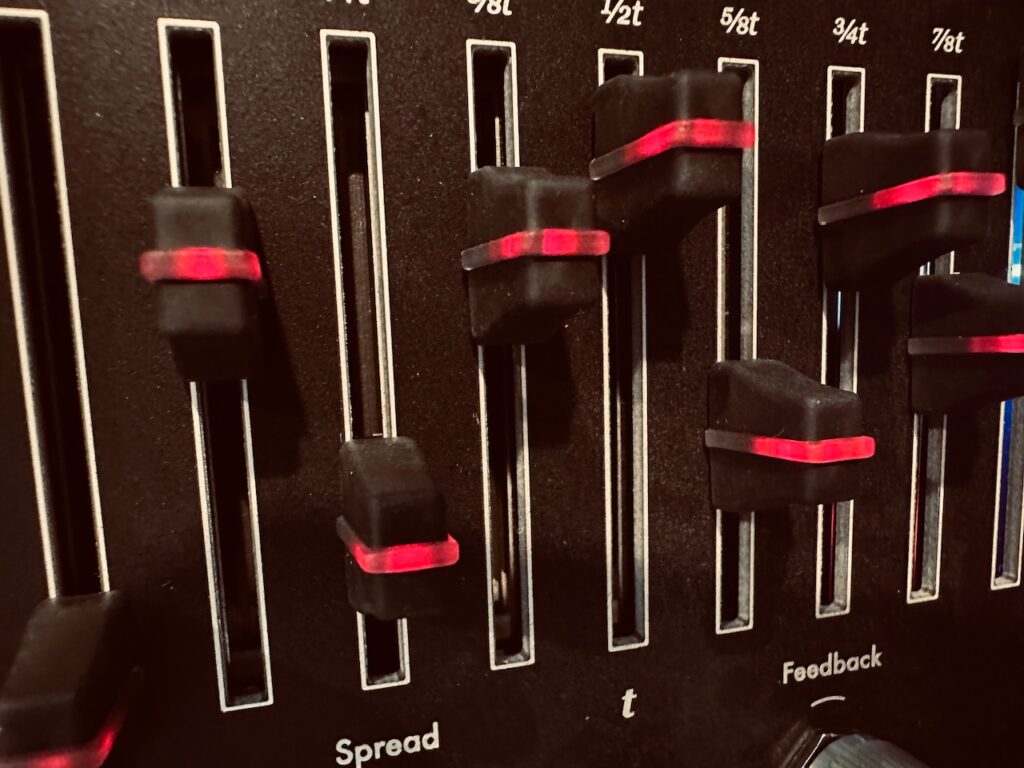
Another accompanying effect used in the patch is the always beautiful Rossum Electro-Music Panharmonium. I’ve found Panharmonium to be indispensable in my patches, and have written about it before, as it allows me to fill sonic holes in a very organic way, using the main driver of the composition as its muse. Pitching the Panharmonium up or down to suit my needs, I can fill gaps in the frequency spectrum, or avoid the clashing of instruments in a particular spectrum. I also frequently use it for its excellent ability to fill space, especially in patches that are otherwise sparse, and since it follows its input directly, it’s always harmonically related. In this patch I pitched Panharmonium down an octave using cross faded sines, and ran it through the Bizarre Jezabel Mimosa as an insert, adding progressively more and more distortion as the piece progressed, with it running full wet, though not full distortion, by the end. This creates a bed of pads for these meandering rhythms to float through, while filling space in the frequency spectrum. It helps create texture, and gives the composition some weight.
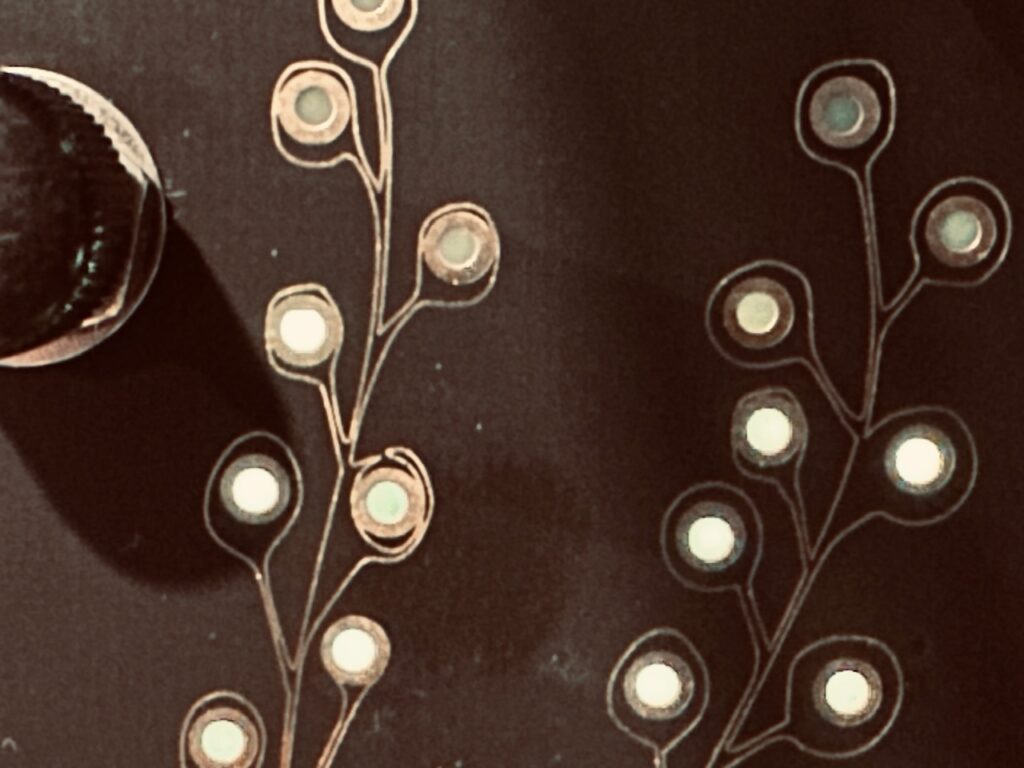

A pair of Pladask Elektrisk Dradds also made an appearance, even if it didn’t really work out. Using the dry sequence and its many repeats from the Time Machine, my first thought was to fade the granular outputs of the Dradds in and out. Something to add some ornamentation to the patch, but without being prominent. It sounded great when I was setting it up, but is barely audible for most of the patch. Which brings me to the new SetonixSynth Shaka modular voltage controlled stereo matrix mixer.
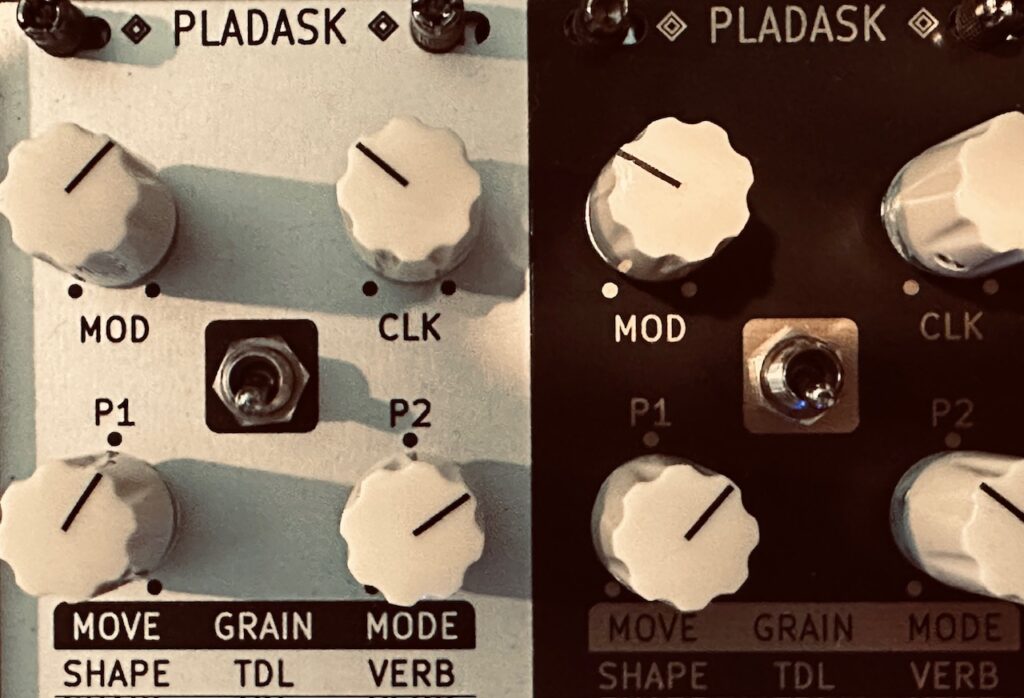
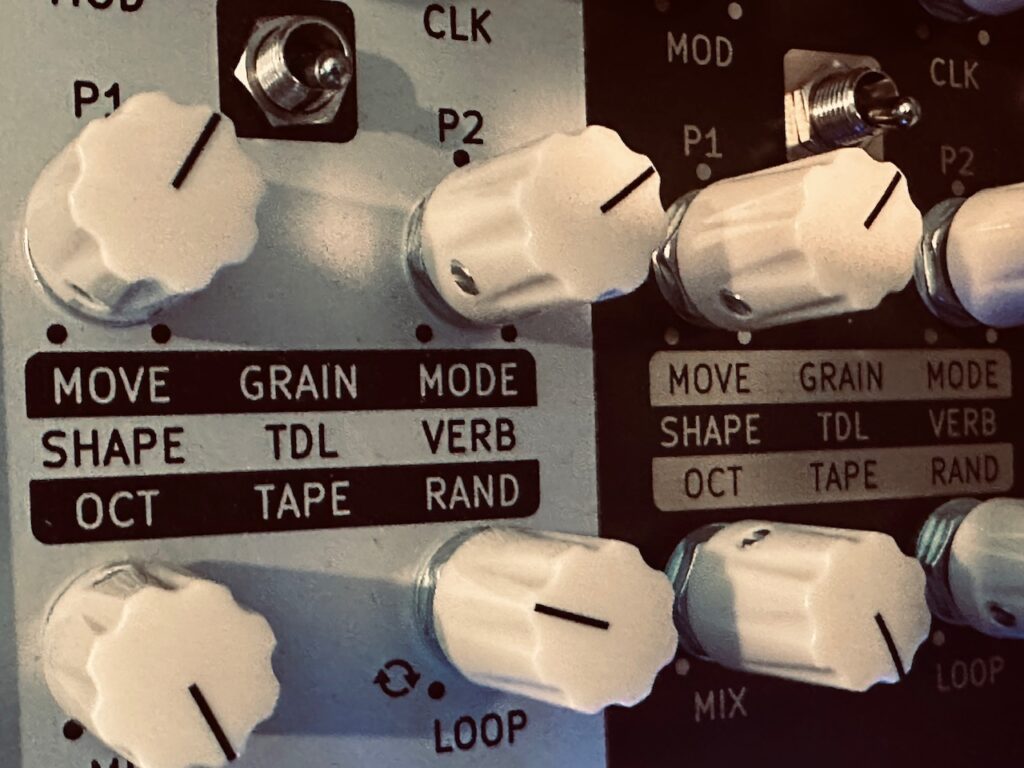
It’s also no secret that I really like the AI Synthesis 018 Stereo Matrix Mixer. It fundamentally changed the way that I patch and how I go about composing pieces from the moment it was first installed. It opened up a lot of opportunities for how I enjoy patching in modular. I’ve used it in literally every patch since it went in the case. It prompted me to buy the also excellent Atomosynth Transmon voltage controlled matrix mixer. When SetonixSynth announced earlier this summer that they would be releasing a voltage controlled stereo matrix mixer, I knew I was going to get it. I quickly joined the pre-sale mailing list which would give a goodly discount on the first units sold. As soon as I got the email with a link a couple of months later, I went ahead and purchased a Shaka 8 and two Shaka 4 expanders for a four input, four output voltage controlled stereo matrix mixer. There’s the very real possibility that I purchased the first one sold once that link went live. As soon as I got it, it went in the case. I used it in my first patch after putting it in, though I didn’t use any voltage control, opting to see just how close it is to the AI Synthesis on an even playing field. It sounded great. Like the AI Synthesis, the Shaka system is made foremost with high quality sound in mind. But I did notice that the exponential nature of the volume control was unlike anything I’d used before. There’s no sound output until you get to about noon on the dial, and it moves up rather quickly from there. According to the developer, at full attenuation, the output is at -100dB, while it’s still a remarkable -50dB with the dial at noon, maxing out at unity gain (8v) at full clockwise. Adding CV up to 10v can output your signal at +20dB. But that leaves just half a knob twist to dial in the level of each node, making fiddling with knobs a must, and the need for precision is paramount, especially if you’re to perform with it. I won’t say I had trouble dialing in good levels with the knobs. It was easy enough, even if that meant paying much closer attention to a simple process than I normally might.
But once I decided to try and use CV control with this patch, I was stymied by the exponential nature of the level control. I’ve never used an exponential VCA before. All of mine are either linear, or somehow switchable between linear and logarithmic. I was trying to do relatively simple things that I’ve done since my very first patch, like using a cycling envelope to open and close a VCA, and I simply couldn’t figure it out. My first thought was that since the VCA is fully open at 8v, I’d send an 8v envelope in the CV input for a channel and everything would be right with the world. Only it wasn’t. With an 8v envelope from Zadar and the knob at full CCW, I got virtually nothing from the output. I would hear the two Dradds granular-ing away for perhaps two seconds of a 20 second envelope. I couldn’t get any sound at all until the envelope was higher than 6v. I was stumped, with no idea what the problem was, much less a solution. I tried adding some offset with the knob, but that only led to blowing the signal out quickly. I never did find a good solution, hence the sparse appearance of the Dradds.
But hope isn’t lost. In the Shaka thread at Modwiggler, I noted my frustration and was given a couple of tips by the developer. He admits that using CV will take some adjustments to how one might normally patch a VCA. In his last response to me he noted, “With such a slow moving LFO, your best bet is probably to attenuate it more into the range you want. The full attenuation of this module is -100dB, the maximum allowed by the VCA it’s using, so at 10 o’clock it attenuates by -65dB and at noon it attenuates by -50dB. Depending on the input signal that is still a lot of attenuation, so is probably where you want to start for many applications.” He further goes on to say that having silence was his goal at full attenuation, noting that it was the largest concern from testers during development. Having had mixers and other gear that bleeds audio where it doesn’t belong, whether in an output or via crosstalk between separate channels, I can’t say that I blame him. If it’s not a vactrol based device, it shouldn’t ever bleed.
That said, this needed conditioning of CV before going to a VC mixer seems to be trading one hurdle for another. A voltage controlled mixer is desired so that you don’t need separate VCAs to manage signal levels. They’re built right in. That’s a highly desirable feature, especially with stereo signals. But if I need a VCA, or an attenuator, to condition my CV for use in the mixer CV inputs, I’ve simply traded out the reason why I need a VCA pre-mixer. It’s a side step, when the point is an improvement. An external VCA is an external VCA whether it’s used for note shaping before a mixer or envelope attenuation in order to shape the note in the mixer. Add in the relative complexity of having to carefully attenuate and shape the CV alongside meticulous knob placement on the mixer itself so that the CV functions in the way you think it should, and I’m not yet convinced that this particular implementation a real step forward. I’m not yet ready to give up on the Shaka system. It’s a very powerful idea that could bring yet another boon to my patching in the same way the AI Synthesis 018 did over a year ago. But if these VCAs don’t function like virtually every other VCA I regularly use, and CV preparation is more of a chore than simply using a VCA for note shaping before the mixer, I’ll have to re-evaluate its place in my rack.
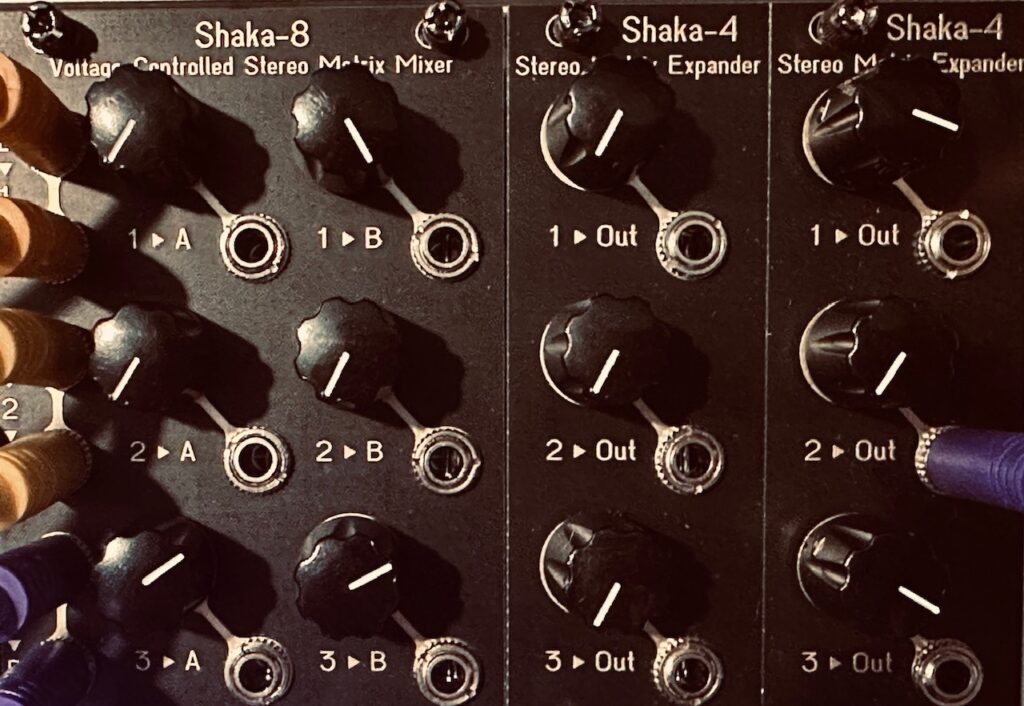
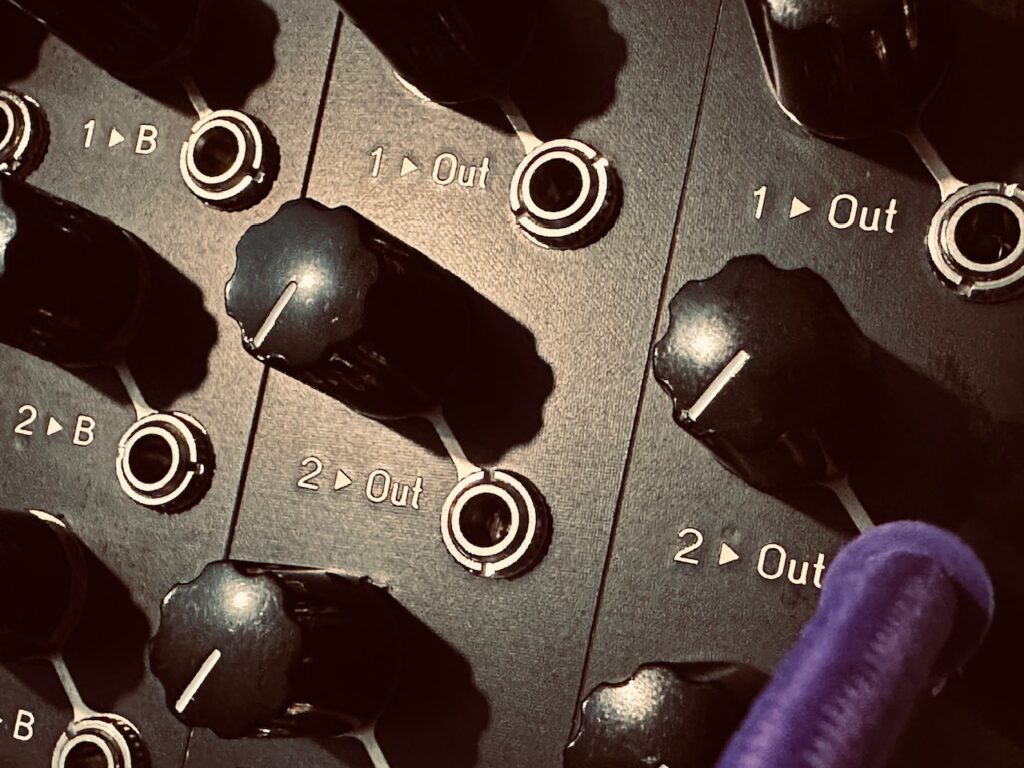
Unfortunately I was unable to get good CV control over the Dradds’ level, and it only peeks through seldomly, and for only a short time. Fortunately my inability to get good CV control over the Dradds wasn’t a crucial part of the composition, and despite its absence, the patch sounds great.
The last part of the patch couldn’t be simpler. The kick drum is a simple filter ring with the Frap Tools Cunsa. The same envelope used to hit the filter input is also used as FM to give the drum a bit more punch. The hats are just as simple, using white noise from Sapel that is patched through Cunsa using a HP output. The VCA in Cunsa is hit by an envelope with a very lightly modulated decay to introduce some difference. Something between a fully closed “tic”, and a very slightly opened “pshh.” Both envelopes are clocked originally from that same regular downbeat of the four step sequence, but it’s patched through Pamela’s Pro Workout. Both outputs are at a 2x multiplier, with the hi hat output being shifted 50% to be on the offbeat.
Overall, this was a really fun patch to make. I had an idea that I was able to bring to fruition, despite some difficulties with a new piece of gear. I’ll keep working with the Shaka system until I either conclude that it’s better than the AI Synthesis 018, or I’ll sell it and wait for the next alternative.
Modules Used:
Nonlinearcircuits The Hypster
Nonlinearcircuits Numberwang
Nonlinearcircuits Let’s Splosh
Nonlinearcircuits Frisson
Nonlinearcircuits De-Escalate
Atomosynth Transmon
Joranalogue Audio Generate 3
Rabid Elephant Natural Gate
SetonixSynth Shaka 8 + 2x Shaka 4
Rossum Electro-Music Panharmonium
Olivia Artz Modular Time Machine
Bizarre Jezabel Mimosa
4ms Shaped Dual EnvVCA
Xaoc Devices Zadar
Schlappi Engineering Boundary
Frap Tools Falistri
Frap Tools Cunsa
Frap Tools Sapel
Intellijel Amps
Pladask Elektrisk Dradd
Knob Farm Ferry
Pamela’s Pro Workout
Pedals Used:
Vongon Ultrasheer
Performed and recorded in 1 take in AUM on iPad via the Expert Sleepers ES-9.
- Or how how the turn signal in your car will drift in and out of time with music or another car’s turn signal. ↩︎
- As explained in the Generate 3 manual, “[The Core output] is the 10 Vpp triangle wave output straight from Generate 3’s VCO core. Also note that it is at half the frequency of, so one octave below, the fundamental output, and thus can be used as a sub-octave signal” The manual continues on to note that the “Even” output is a saw wave at twice the frequency of the fundamental, the odd is an octave and a half higher (beginning on the 3rd harmonic), and the “Full” wave being all harmonics, including the fundamental. ↩︎


